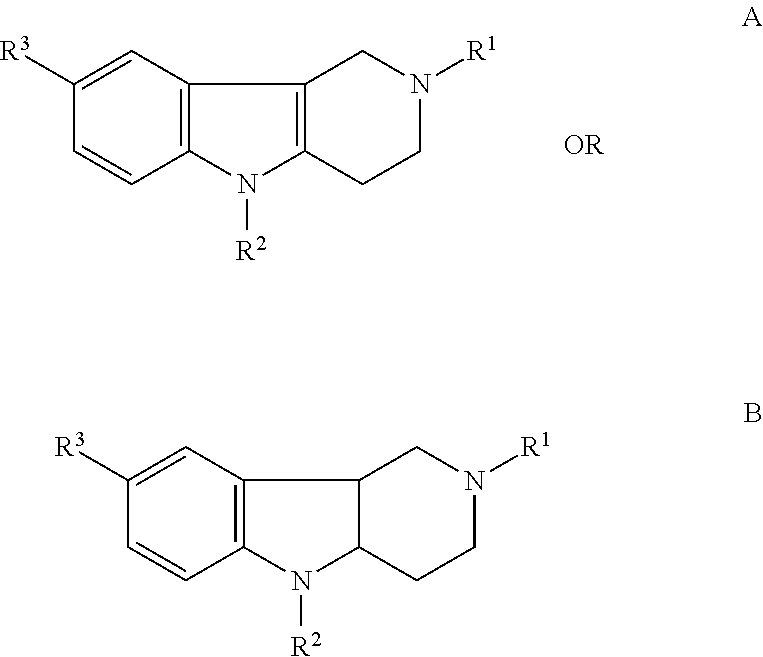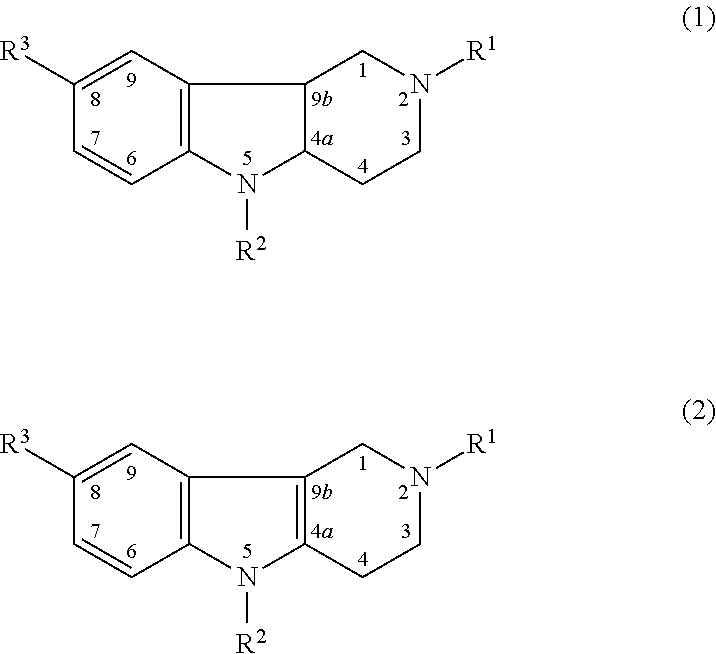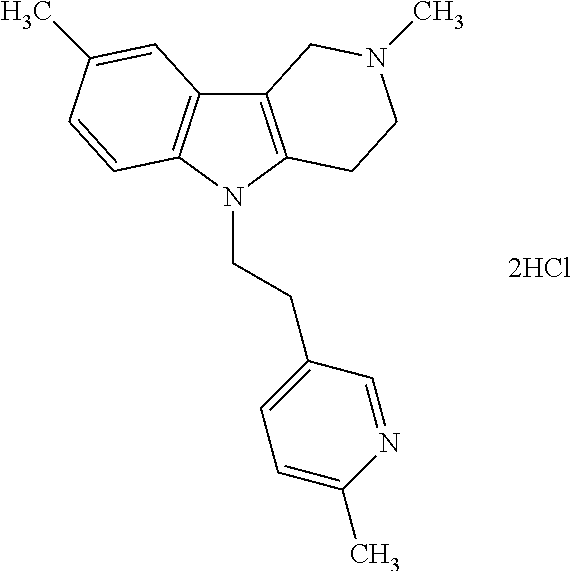Methods and compositions for treating schizophrenia using antipsychotic combination therapy
a combination therapy and antipsychotic technology, applied in the field of medicine, can solve the problems of affecting health and well-being, the most severe and difficult to treat, and the most severe and difficult to treat, and achieve the effects of reducing side effects, increasing activity, and significantly less occurrence of neuroleptic side effects
- Summary
- Abstract
- Description
- Claims
- Application Information
AI Technical Summary
Benefits of technology
Problems solved by technology
Method used
Image
Examples
example 1
Method of Evaluating the NMDA-Induced Current Blocking Properties of the Compounds
[0105]The drug “dimebon,” 2,8-dimethyl-5-[2-(6-methylpyridyl-3)ethyl]-2,3,4,5-tetrahydro-1H-pyrido[4,3-b]indole dihydrochloride of the Formula:
was taken as a representative of the compounds described herein.
[0106]Experiments were carried out by the patch clamp method on freshly isolated neurons of a rat brain cortex or on cultured rat hippocampus neurons. Neurons for cultivation were obtained from the hippocampus of neonatal rats (1-2 days) by the method of trypsinization followed by pipetting. Cells suspended in culture medium were placed in 3 mL quantities into the wells of a 6-well planchette (Nunc) or into Petri dishes, in which glasses coated with poly-L-lysine had first been placed. The cell concentration as a rule was 2.5×10−6-5×10−6 cell / mL. The culture medium consisted of Eagle's minimum medium and a DME / F12 medium (1:1) supplemented with 10% calf serum, 2 mM glutamine, 50 μg / mL gentamycin, 15...
example 2
Use of an in Vivo Model to Determine the Ability of Compounds of the Invention to Treat, Prevent and / or Delay the Onset and / or the Development of Schizophrenia
[0112]In vivo models of schizophrenia can be used to determine the ability of any of the hydrogenated pyrido[4,3-b]indoles described herein (e.g., dimebon) to treat and / or prevent and / or delay the onset and / or the development of schizophrenia.
[0113]One exemplary model for testing the activity of one or more hydrogenated pyrido[4,3-b]indoles described herein to treat and / or prevent and / or delay the onset and / or development of schizophrenia employs phencyclidene, which is chronically administered to the animal (e.g., non-primate (rat) or primate (monkey)), resulting in dysfunctions similar to those seen in schizophrenic humans. See Jentsch et al., 1997, Science 277:953-955 and Piercey et al., 1988, Life Sci. 43(4):375-385). Standard experimental protocols may be employed in this or in other animal models.
example 3
Use of Human Clinical Trials to Determine the Ability of Compounds of the Invention to Treat, Prevent and / or Delay the Onset and / or the Development of Schizophrenia
[0114]If desired, any of the hydrogenated pyrido[4,3-b]indoles described herein (e.g., dimebon) can also be tested in humans to determine the ability of the compound to treat, prevent and / or delay the onset and / or the development of schizophrenia. Standard methods can be used for these clinical trials.
[0115]In one exemplary method, subjects with schizophrenia are enrolled in a safety, tolerability, pharmacokinetics and pharmacodynamics phase I study of a hydrogenated pyrido[4,3-b]indole using standard protocols. Then a phase II, double-blind randomized controlled trial is performed to determine the efficacy of the hydrogenated pyrido[4,3-b]indole.
PUM
| Property | Measurement | Unit |
|---|---|---|
| elimination half life | aaaaa | aaaaa |
| elimination half life | aaaaa | aaaaa |
| elimination half life | aaaaa | aaaaa |
Abstract
Description
Claims
Application Information
 Login to View More
Login to View More - R&D
- Intellectual Property
- Life Sciences
- Materials
- Tech Scout
- Unparalleled Data Quality
- Higher Quality Content
- 60% Fewer Hallucinations
Browse by: Latest US Patents, China's latest patents, Technical Efficacy Thesaurus, Application Domain, Technology Topic, Popular Technical Reports.
© 2025 PatSnap. All rights reserved.Legal|Privacy policy|Modern Slavery Act Transparency Statement|Sitemap|About US| Contact US: help@patsnap.com



